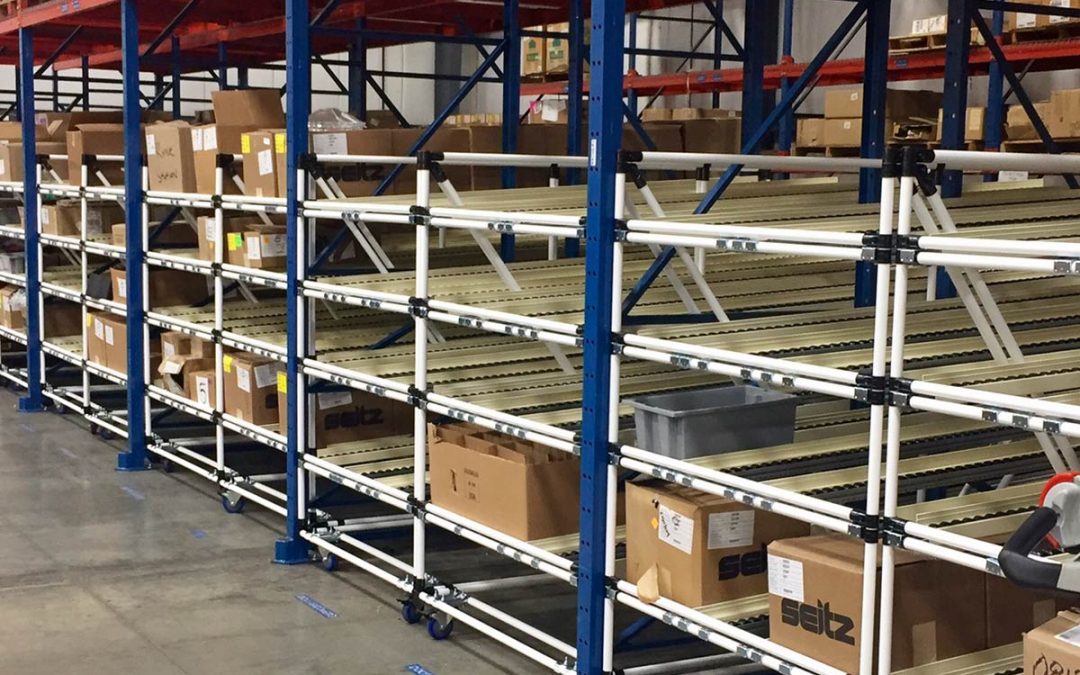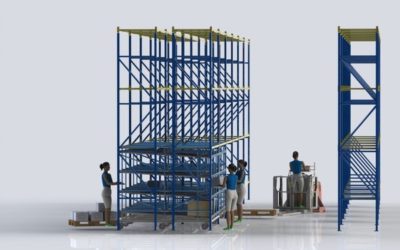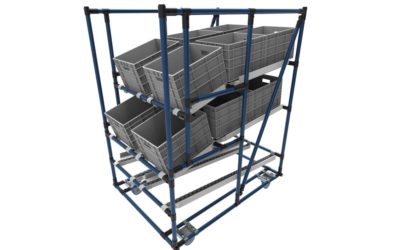There are four main groups of physical equipment that support material flow: carts, workstations, packaging, and flow racks. Of those four groups, flow racks are the least understood. It may be because the others are encountered in normal life – if you go to any grocery store, car shop, mall, or even restaurant you’ll encounter various kinds of carts, workstations, and packaging. Not so much for flow racks, although they are often there but just not as visible, providing specific and useful functions.
What are flow racks?
Not to be obvious, but it’s a rack that helps with the flow of materials: material is introduced on one side and flows through the unit to the other side. They are also commonly referred to as live storage racks, point of use racks, gravity feed racks, and flow chutes, among other names. The characteristics of a flow rack are usually defined by the external footprint, the number of levels (rows), and the number of lanes (columns).
How do they work?
The “flow” part of flow rack is almost always accomplished by gravity, making flow racks unique among the other types of equipment in that they move material without human action. The mechanism of flow can be roller tracks with wheels or an angled, flat surface that allows free movement.
Flow racks can be designed to move unpackaged parts, cardboard boxes, totes, bins, pallets, or almost any other kind of material. Custom flow racks can be designed at various dimensions, lanes, and levels along with other specific adjustments to fulfill specific functions.
Where are flow racks used?
If we use the term flow chutes, which is a specific kind of flow rack, you may get a different mental image – a slide. Take a ball and roll it down a slide, that’s a flow chute. The rear load refrigerators in gas stations and party stores often have angled shelves that flow bottles and cans in dedicated lanes from back to front, those are flow racks. Fast food kitchens use flow chutes to move items from the kitchen to the order picker. Once you start to think about flow racks, you see them in more places than you would expect.
In manufacturing and distribution environments, flow racks are used everywhere – warehouse, supermarket, kit cell, lineside area, and pack out zone.
Why should you care?
Flow racks fulfill three important functions in manufacturing and distribution environments:
- Define boundary areas. Flow racks separate the delivery area from the operator work zone. They create separation between those two functions. This is more common in manufacturing than distribution but is becoming more recognized in distribution environments as orders get smaller and move faster.
- Control material flow. An eight-foot-long flow rack can only hold eight feet worth of boxes. Another obvious statement, right? But it stands in contrast to an open spot on the floor that can hold as many pallets as the forklift operator can squeeze in there, yellow tape be darned. Flow racks are a support mechanism to a production control and logistics team to apply the right processes. Error proofing systems can be introduced to only allow the loading and picking of the correct items in the correct locations.
- Create material presentation. Provide the right material, in the right quantity, in the right space, to the operator, at the right time. Reduce the guessing, lifting, bending, and reaching in your process.
What do I get out of using flow racks?
- They promote first in, first out (FIFO). New materials enter, and the oldest materials reach the operator first.
- They keep inventory in control and moving. Only a defined amount of product will fit on the rack, and each lane is used by a specific item.
- They visually organize material. This makes everything easy to see and understand the current status, as well as reducing wasted time searching for parts.
- They are customizable (well, ours are!). Flow racks can be designed for specific materials for your specific process to ensure that the needs of the operators, parts, and process are met.
- They are ergonomic. Ergonomics are so important yet often ignored. Well-designed flow racks are optimized for operator ergonomics, reducing wasted movement and reaching. Excessive lifting and bending are reduced, along with holding all materials in small hand totes that can be moved easily.
Our custom flow racks facilitate engineered material flow to save time, money, and effort. Schedule a design session to create flow racks that perfectly fit your processes.




